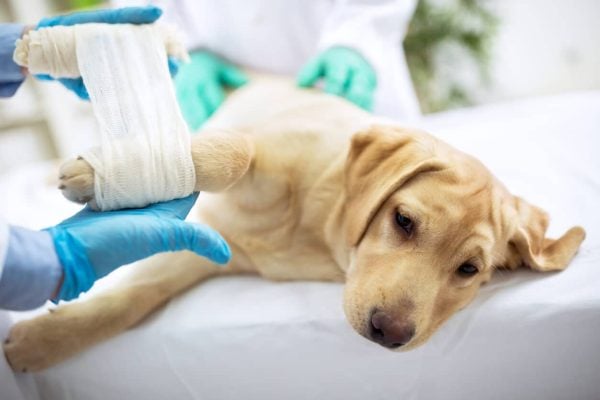- Not a substitute for professional veterinary help.
It’s not always easy to tell whether your dog’s illness or injury is an emergency or something that can wait for a regular vet appointment. In serious cases, acting fast can be lifesaving, but not every situation calls for a late-night trip to the ER.
How can you tell if your dog truly has an emergency? Check whether they’re having difficulty with essential life functions, including breathing, eating and drinking, urinating and defecating, and resting comfortably, advises Dr. Morgan Gunn, emergency veterinarian at VEG ER for Pets.
If they’re having trouble with these essential functions, you should get them to the vet right away.
Read on to learn the signs of emergency and when to seek immediate care for your pup.
Signs To Take Your Dog to the Emergency Clinic
Signs your dog needs emergency care include:
- Severe bleeding, or bleeding that doesn’t stop within five minutes
- Choking, difficulty breathing, or persistent coughing and gagging
- Bleeding from the nose, mouth, rectum
- Signs of blood in urine or vomit
- Inability to urinate or pass stool, or signs of pain while trying to do so
- Eye injuries
- Ingestion or possible ingestion of something toxic, like antifreeze, xylitol, chocolate, or rodent poison
- Seizures or staggering
- Broken bones, severe limping, or inability to move a limb
- Signs of pain, distress, or extreme anxiety
- Excessive drooling, panting, or collapse in warm weather
- Severe vomiting or diarrhea, especially when combined with other serious symptoms
- Refusal to drink water for more than 24 hours
- Loss of consciousness or unresponsiveness
“If you’re ever wondering if an ER visit is needed, you can always call your local veterinary ER and ask if your pet should be seen,” says Dr. Carly Fox, a senior veterinarian in the Emergency & Critical Care Service at the Schwarzman Animal Medical Center.
Common Causes of Emergencies
According to Drs. Gunn and Fox, some of the most frequent reasons dogs are brought to the emergency room include:
- Vomiting and diarrhea: Frequent vomiting or diarrhea, especially with blood or signs of dehydration, can quickly become dangerous.
- Ingestion of foreign materials or toxins: Swallowing objects, foods, or chemicals can cause choking, poisoning, or dangerous blockages that require emergency treatment.
- Trauma: Traumatic injures from getting hit by a car, falling from a height, getting an electric shock, nearly drowning, or being bitten by another dog can cause internal bleeding and organ damage.
- Gastric dilatation-volvulus (GDV): A swollen belly, restlessness, and unsuccessful attempts to vomit may signal life-threatening stomach twisting caused by bloat.
- Heatstroke: Excessive panting, drooling, and collapse in warm weather can suggest heatstroke or dangerous overheating.
- Seizures: Uncontrolled shaking, twitching, or sudden collapse can suggest abnormal brain activity, which requires urgent care.
- Severe allergic reactions: Sudden facial swelling, hives, vomiting, or breathing trouble may point to a serious allergic response.
- Difficulty breathing (respiratory distress): Struggling to breathe or heavy coughing suggests an emergency affecting your dog’s airways.
- Urinary blockages: Straining without producing urine or crying out while trying to urinate—especially for male dogs—can signal a life-threatening blockage.
- Heart conditions: Sudden weakness, coughing, rapid breathing, or fainting could indicate heart failure or arrhythmia.
Any sudden or dramatic change in your dog’s behavior, movement, breathing, or appearance is a good reason to call your vet or head to the ER—even if you don’t know the cause of those symptoms!
Dog First Aid
While we hope you’ll never need it, a pet first-aid kit can be very helpful for treating minor injuries, managing emergencies until you can reach a vet, and preparing for unexpected events like natural disasters or evacuations.
What to include in your dog’s first-aid kit
Start by gathering important documents and information, including:
- Your vet’s contact information
- A nearby 24/7 emergency vet number
- Your dog’s vaccination records
- A recent photo of your pet
- The ASPCA Poison Control number: (888) 426-4435
Next, stock up on essential dog first-aid supplies, including:
- Gauze and vet wrap for bandaging wounds
- Blunt-end scissors and tweezers
- A digital pet thermometer
- Cotton balls, swabs, and an instant cold pack
- A flashlight or penlight
- Nail clippers
- A soft recovery collar
- Dog-safe antibiotic ointment
- Vetericyn wound spray
- Activated charcoal and hydrogen peroxide—but use it only with veterinary guidance
- A pet first-aid guidebook, like The First Aid Companion for Dogs & Cats
Tip: Keep these items together in a waterproof bin so you can easily grab it when needed.
Learn more about creating a dog first aid kit here.
Emergency Numbers and Hotline
If you can’t immediately reach your vet or get to an emergency clinic, you can try calling a trusted hotlines for help in the meantime. These services can guide you on what steps to take next and help determine whether your dog needs urgent, in-person care.
Important numbers to have include:
- ASPCA Animal Poison Control Center: Call (888) 426-4435 for advice on poisonings, toxin exposures, and ingestion emergencies. A consultation fee may apply. Available 24/7.
- Pet Poison Helpline: Call (855) 764-7661 for pet poisoning emergencies, including foods, plants, chemicals, and medications. Consultation fees typically apply. Available 24/7.
- Your veterinarian’s office: Save your regular vet’s number in your phone and keep it written down somewhere accessible. Even if they’re closed, many clinics will give an emergency referral number on their voicemail.
- Nearest 24/7 emergency vet hospital: Identify the closest emergency animal hospital before you need it. Some clinics allow you to call ahead to let them know you’re coming, which can save precious minutes.
- Tele-triage services for pets: Services like VetTriage connect you with trained experts who can assess your dog’s situation, offer first aid advice, and guide you on what to do next.
Remember: when in doubt, it’s always better to play it safe and reach out for guidance. Acting quickly could save your dog’s life!




